Home » Indoor Sports Court » Weight Room Flooring Buyer’s Guide for High Schools and Colleges
Weight Room Flooring Buyer's Guide for High Schools and Colleges

The need for quality weight room flooring transcends various organizations – from schools and colleges, where budding athletes take their first steps, to high-performance sports clubs, where the pursuit of fitness is a daily routine. Each setting demands a unique approach to flooring, tailored to its specific use and user demographics. Understanding these nuances is key to making an informed decision.
For decision-makers at educational institutions, and sports clubs, selecting the right flooring for a weight room is a critical decision that impacts not only the budget but also the safety and effectiveness of the training environment. This guide aims to navigate you through the complexities of costs, design, materials, and funding, ensuring your investment yields a functional, durable, and safe space for athletes and fitness enthusiasts.
Cost to Install Weight Room Flooring
The cost of weight room flooring can vary significantly, typically ranging somewhere from $46,000 to $185,000. This variation is influenced by several factors, including the choice of flooring material, quality of the material, size of the area, design complexity, and installation requirements. It’s crucial to balance your budget with your specific needs to find a flooring solution that offers both quality and value.
Try our weight room flooring cost calculator to get a customized cost estimate for your rubber gym flooring installation project in a matter of minutes.
What Influences the Cost?
- Size of the Area: Larger spaces require more materials and labor, directly impacting the cost.
- Quality of Materials: High-quality, durable materials like thick rubber or specialized composites are more expensive but offer longevity and better performance.
- Design Complexity: Custom designs, colors, or logos increase costs.
- Installation Requirements: Professional installation, while adding to the upfront cost, ensures longevity and safety of the flooring.
- Maintenance Needs: Opting for low-maintenance materials can reduce long-term costs.
- Geographical location: In the end the final price tag always depends on where your sports facility is located. Labor and logistical costs vary significantly across the United States between cities and states.
Kick Off Your Gym Flooring Project
We’ve created a comprehensive set of tools designed to assist facility managers and project planners in initiating their projects and connect them with the professionals in the industry.
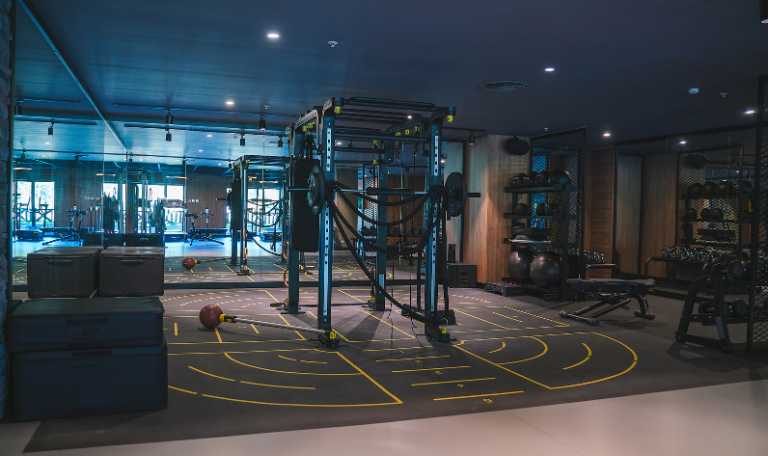
Weight Room Floor Plan and Layout
The design and layout of a weight room floor must reflect the specific activities it will support. Heavy lifting areas require thicker, more durable flooring to withstand the impact, while areas designated for cardio or stretching might need softer, more flexible surfaces. The layout should facilitate a logical flow of movement, minimizing the risk of accidents and ensuring easy access to equipment.
Before the start of a gymnasium or weight room flooring project it is essential to make a floor plan that lays out the different sections of the gym, the dimensions of each section and the flooring materials that are to be used in each zone.
Consider also who are the main users of your gymnasium and which floor type would fit their needs best:
- At elementary and middle school level younger students, that don’t use heavy weights, any flooring material would work.
- When you get to high school level, you’ll need something more durable. The consistent use of heavy weights means you need a material that will withstand constant impact.
- If your weight room will be used by college athletes, you need the best of the best. These athletes are working with heavy weights on a daily basis and need a floor that can stand up to the wear and tear.
- For sports clubs serving both recreational and professional athletes, it’s essential to have flooring that supports a range of activities, from high-intensity workouts to weightlifting. A multipurpose option like rubber flooring is ideal.
Weight Room Flooring Material Options
Rubber Weight Room flooring
Possibly the most common type of weight room flooring is rubber. This material is versatile, durable, and easy to install; which makes it a great choice for schools and gyms of all sizes.
Within the category of rubber flooring, there are choices to be made.
1 – Interlocking weight room flooring
Interlocking tiles and pads are fantastic for gyms that are constantly moving and shifting to accommodate different activities. The ease of installation and removal make them a popular choice for schools that need to quickly transition their weight room to another activity, such as a wrestling meet or aerobics.
With this method, squares of rubber are pieced together much like a jigsaw puzzle. Once the entire floor is covered, or the area that needs protection is covered, the mats are interlocked together to create a smooth, seamless surface.
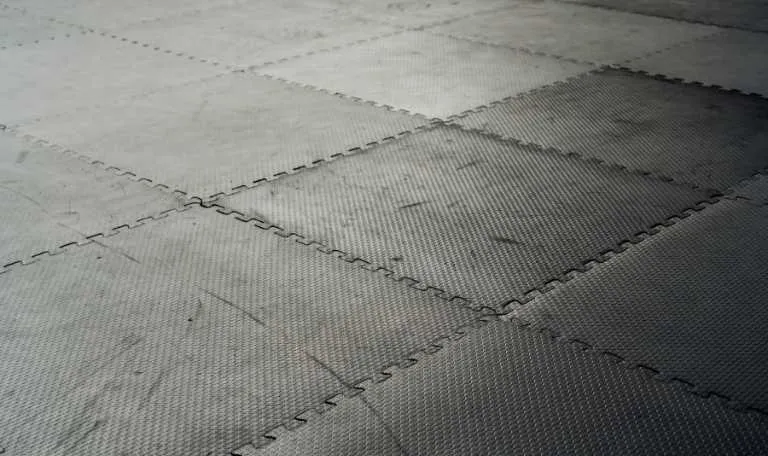
2 – Stacked rubber weight room floor mats
This method is similar to the interlocking panels, except that the rubber mats are stacked on the weight room floor for added cushion and impact resistance. This is a great option for weight rooms that see a lot of traffic and need extra protection for their athletes.
By placing a higher density rubber on top of a softer more springy layer, your athletes will be better protected from impact-related injuries.
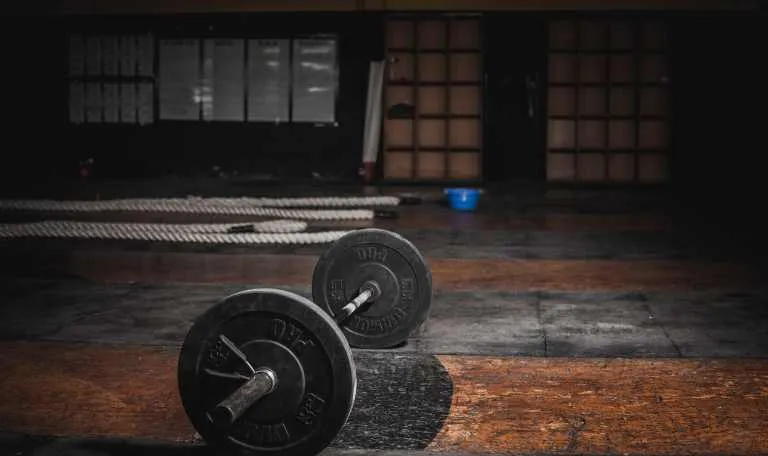


3 – Vulcanized rubber weight room flooring rolls
This is a sheet of rubber that comes in rolls. The production process uses chemicals that render the surface impermeable to liquids. This is the best choice for weight rooms that are exposed to moisture, such as those in humid climates or near pools.
Vulcanized rubber is a great choice for weight rooms that want the seamless look of a single piece of flooring. It can cover large areas and present a smooth appearance – perfect for a weight room in an athletic club or high-tier competitive setting.
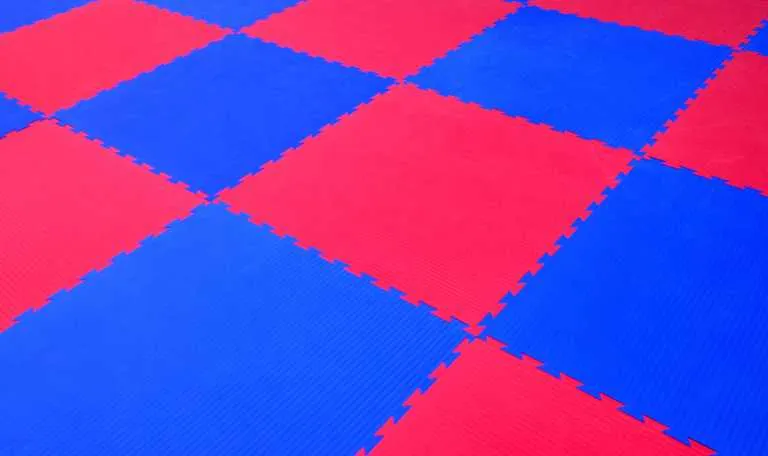


4 – Virgin rubber weight room flooring
The final type of rubber flooring is virgin rubber. Available in both squares and rolls, virgin rubber helps you elevate the aesthetic of your facility.
You can match the color to your brand and school, to reinforce the experience for your athletes.
Kick Off Your Gym Flooring Project
We’ve created a comprehensive set of tools designed to assist facility managers and project planners in initiating their projects and connect them with the professionals in the industry.


Sheet vinyl weight room flooring
The second choice on our list is vinyl flooring for your weight room. Like rubber, it’s easy to install and attractive.
Vinyl flooring comes in a variety of colors and styles. You can find tiles that look like wood or stone, which can give your weight room a more luxurious feel.
Most vinyl is water-resistant, making it great for athletic spaces looking to protect their investment (and their athletes). You can easily mop up spills, clean up after sweaty workouts, and keep your weight room looking great.
However, there are some drawbacks to vinyl flooring for weight rooms. Because of vinyl’s penchant to dent or crack, weight rooms that are dedicated to heavy free weights and dumbbell exercises should steer clear. Rubber is the smarter choice for long-term durability in these cases.
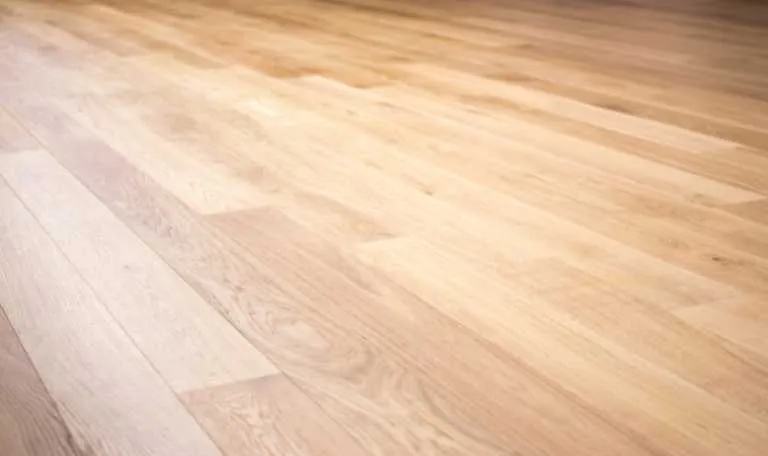


Hardwood flooring for weight rooms
One final popular choice for weight room flooring is wood. Wood floors are beautiful, classic, and luxurious. They create an air of sophistication that can take your weight room to the next level.
However, wooden floors are also one of the most expensive options on this list.
They require more care and maintenance than other materials, and they’re susceptible to water damage.
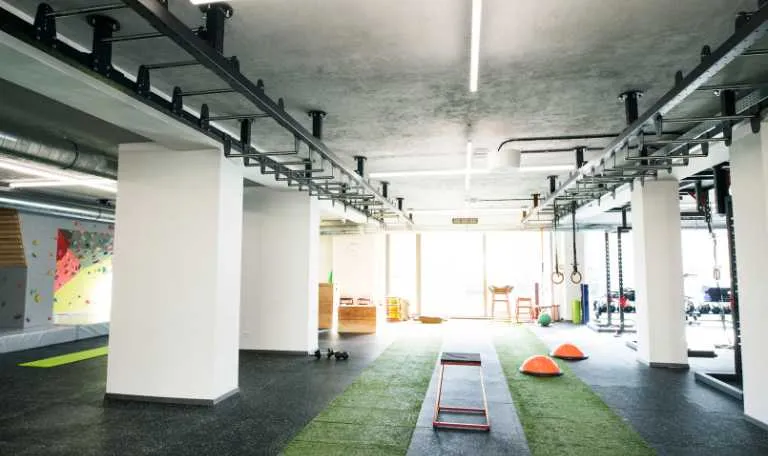


Gym turf flooring
Artificial turf flooring has become a favored option in modern weight rooms, particularly for areas designated for dynamic activities like functional training, agility drills, and sled work. This type of flooring is crafted from synthetic fibers, designed to replicate the look and feel of natural grass, which not only adds an aesthetic touch of greenery but also provides a versatile surface suitable for a variety of exercises.
One of the key features of artificial turf is its durability. It’s engineered to withstand the rigors of heavy foot traffic and intense workout sessions, making it an ideal choice for high-activity areas in a gym or training facility. This resilience also translates to lower maintenance needs compared to natural grass; it doesn’t require watering, mowing, or fertilizing, making it a practical and cost-effective solution in the long run.
In terms of comfort and safety, many artificial turf options come with a padded underlayer. This addition enhances shock absorption, which is beneficial for exercises that involve jumping or running, reducing the impact on joints and minimizing the risk of injuries. It’s a feature that’s particularly appreciated in settings where a variety of activities take place, from high-intensity workouts to more moderate exercises.


Different Materials for Different Sections at the Gym
1 – Cardio / Fitness zone
In this area your athletes will spend a lot of time making contact with the floor or sweating on the cardio machines. You will need a floor material that is somewhat shock absorbent, but more importantly is not sensitive to humidity and is easy to sweep up and clean.
Synthetic flooring (vinyl or rubber) is usually the best option here. Vinyl and rubber gym floors are great for multipurpose use and are resistant to damage.
2 – Heavy weights zone
You’ll need a durable floor that can handle dropped weights. No matter the level of iron pumpers, heavy weights can wreak havoc on your floor. Choose something extremely durable.
Rubber flooring mats, rolls or tiles are the go-to choice for this section.
3 – Sport-specific training zone
You’ll need a floor that can handle the specific activities being performed. For example, the football team will appreciate having a zone for artificial turf, the basketball players would like to play on hardwood floor and aerobics/dance can be performed on synthtetic flooring, such as, rubber or sheet vinyl.
Pro tip: Make a floor plan for your gymnasium, then measure the dimensions for all the different sections. Once the layout and the total surface area for each section are clear, try our weight room flooring cost calculator to get a customized cost estimate.
Customization opportunities
Weight room flooring in schools and sports clubs offers a range of design and customization opportunities to enhance both functionality and aesthetics. Here’s how these environments can optimize their flooring:
For Schools
School Branding: Schools often incorporate their colors, logos, or mascots into the flooring design. This boosts school spirit and creates a unique, personalized environment for students.
Educational Markings: Incorporating educational elements, such as fitness tips, motivational quotes, or workout diagrams directly into the flooring, can create an interactive and engaging space for students.
Functional Zoning: Different colors or patterns can be used to designate specific areas for various activities, such as weightlifting, cardio, or stretching, making the space more organized and user-friendly.
Safety Signage: Integrating safety instructions or guidelines into the flooring design can promote a safer workout environment.
For Sports Clubs
Brand Identity: Sports clubs can use flooring to reinforce their brand identity, using custom colors and designs that align with their branding.
Luxury Finishes: High-end gyms might opt for premium materials or sophisticated designs in their flooring to create a luxurious ambiance.
Interactive Designs: Some gyms incorporate functional designs, like agility ladders or marked sprint tracks, directly into the flooring to enhance the functionality of their space.
Modular Flexibility: Using modular tiles or mats allows for flexibility in design, enabling gyms to easily update or reconfigure their space.
Sub-Floor Materials
When it comes to weight room flooring, the choice of sub-floor material is as crucial as the top layer, playing a significant role in the overall performance, durability, and safety of the flooring system. The sub-floor acts as a foundation, supporting the upper layers and contributing to the floor’s shock absorption, stability, and longevity.
Concrete
One common sub-floor material is concrete, often used due to its strength and stability. Concrete provides a solid base that can support heavy weights and equipment without flexing or deforming. This makes it an ideal choice for weight rooms where heavy lifting and high-impact activities are common. However, concrete is hard and unyielding, which means it doesn’t offer much in terms of shock absorption or comfort. This is why it’s usually paired with a top layer of rubber or foam that can provide the necessary cushioning and impact resistance.
Wood
Another option for sub-flooring is engineered wood. This material offers a balance between rigidity and some degree of flex, which can be beneficial for areas used for aerobic activities or martial arts training. Engineered wood sub-floors can provide a bit more ‘give’ compared to concrete, which can be easier on the joints and muscles during high-impact activities. However, wood may not be as durable as concrete when it comes to supporting very heavy weights, so it’s important to consider the primary use of the weight room when selecting this material.


Case Studies
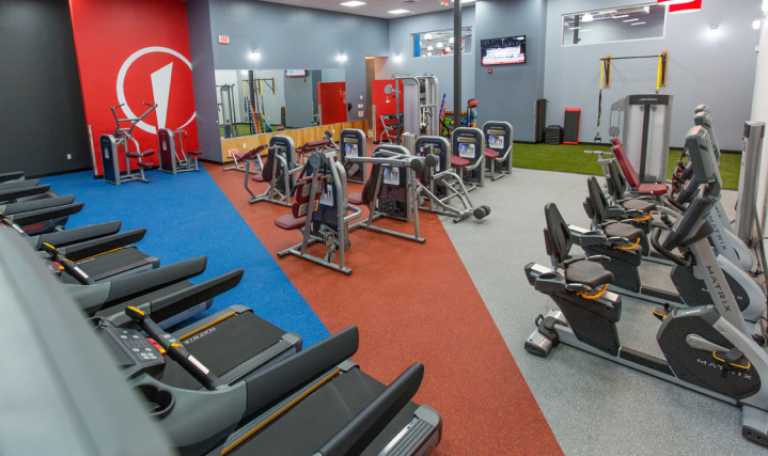

Ecore Flooring Enhances Edge Fitness Clubs’ Expansion
Background: Edge Fitness Clubs, a well-known fitness chain in Connecticut, embarked on an expansion with new facilities in Danbury, Orange, and Manchester, aiming to serve their increasing membership base with diverse workout preferences.
Challenge: The Danbury location required flooring robust enough to withstand the heavy footfall of 12,000-15,000 members, while being versatile for various fitness activities and easy to maintain.
Solution: Eddie Wozniak from Sporttech Fitness & Rehab LLC, drawing on his experience with Edge Fitness, recommended Ecore Athletic’s Performance Motivate and Performance Rally flooring. These products, made with a durable vulcanized EPDM wear layer, were chosen for their longevity and low maintenance needs. The installation covered 15,000 square feet, using Performance Motivate in light strength and conditioning areas and Performance Rally in the free weight area, noted for its force reduction and energy restitution capabilities. A custom color scheme was selected to boost the gym’s visual appeal.
Results: The flooring installation was well-received, praised for both its functional benefits and vibrant design. The Performance Motivate and Rally surfaces met the demands for durability and ergonomic support across various training zones. Additionally, Bounce 2 flooring, resembling wood but offering greater ease of cleaning and economy, was installed in group exercise and children’s basketball areas. The success at the Danbury club has prompted plans to incorporate Ecore products in future Edge Fitness expansions.
Funding Opportunities for Weight Room Flooring
Securing funding for weight room flooring projects can be challenging. Exploring options like government grants, sponsorships from local businesses, allocations from school boards or municipal budgets, and community fundraising can be fruitful. Presenting a strong case that highlights the long-term benefits of quality flooring in terms of safety, performance, and durability is key to securing these funds.
Check out our sports facility grants and funding section to see if you can find funding opportunities for your project.


Selecting a Weight Room Flooring Supplier
Choosing the right supplier is critical. Look for suppliers with:
- Proven Expertise: Demonstrated experience in similar projects.
- Quality Products: A range of options to suit different needs and budgets.
- Industry Memberships and Certifications: Go through the websites and find out if the companies are members of industry associations and if they have obtained relevant certifications in the industry.
- Positive Reviews: Testimonials from past clients.
- After-Sales Support: Availability of maintenance and repair services.
If you are currently looking for a professional and experienced weight room flooring installer, try out gym flooring partner finder to find the ideal partner for your project.
Read more: Top weight room flooring companies in the United States
Conclusion
Investing in the right weight room flooring is a decision that goes beyond mere aesthetics. It’s about ensuring athlete safety, enhancing performance, and optimizing the longevity of the facility. This guide aims to assist decision-makers in navigating this complex process, ensuring that their investment yields a safe, functional, and inspiring training environment. The right flooring can be the foundation upon which athletic excellence is built, making it a decision of paramount importance for the success and reputation of the institution or facility.

